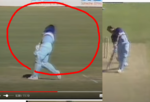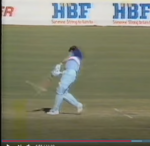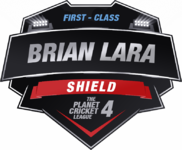Quick example : he's Ian Botham smashing a straight (ish) drive at Perth in 86/7. Note that the front arm is fully extended on contact - that's how you generate power and leverage, by maximising the distance between your front shoulder and the middle of the bat, with orthodox driving technique. The red circle represents (roughly) the arc that the middle of the bat follows on a full power straight drive.
Note that the delivery is a half volley, low shin height, so he makes contact when the ball is level with his front pad, because that's where the arc of the middle of the bat passes through low shin height. And the ball stays on the deck, because the angle of the bat at point of contact is only just past the perpendicular.

This is another drive, but this time the delivery is knee height - so he's hitting at a later point in the arc, because that's when the middle of the bat passes through knee height on a full swing. And the ball goes in the air, because the angle of the bat at that later point in the arc is further past the perpendicular. The height of the ball essentially determines the elevation, given that he's making a full swing and wants to make contact in the middle of the bat.

If he'd made contact level with his pad instead, he'd either have to have cramped his front arm so the arc of the middle of the bat was smaller / higher - which reduces power considerably - or he'd have made a contact higher up the bat, again reducing power considerably. Even as it is, he's made contact a little bit high so the ball goes for 4 instead of 6, despite his huge natural power
Right, so if you imagine a straight delivery that's higher still : as the height increases, the middle of the bat contact point for a full, straight swing goes further out in front, and the angle of the bat goes further past the perpendicular and the elevation increases. Once the ball is much above your front knee, you're either going to get more height than distance, or a bad contact, or a cramped swing (unless you slog to the leg side to flatten the height of the arc, if you get what I mean).
There are wristy players out there who can generate unorthodox hitting arcs to all sorts of deliveries, but those arcs are unavoidably tight and difficult to time, less powerful and will pop up catching practice if the contact is bad.
Unfortunately cricket terminology conflates "timing" and "contact" quite a lot, when there are two distinct and independent concepts in there, both of which contribute to power and elevation.







